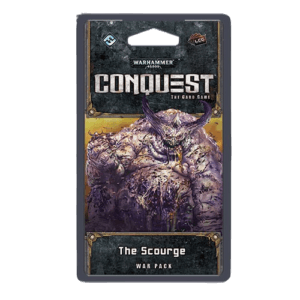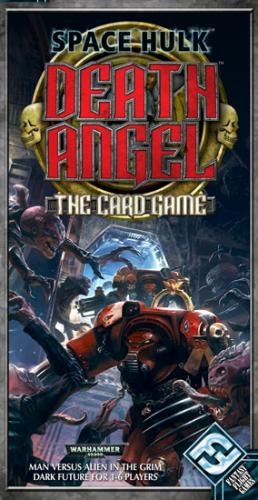Once a novel term, living card games (LCGs) are increasingly commonplace, a chance for designers to dive into an idea without having a perpetual release strategy in mind (though, as with Arkham Horror and Marvel Champions, being open to it doesn’t hurt). Warhammer 40,000: Conquest represents the LCG ideal in one way: it’s complete, and it’s done, and it’s excellent.
If you’ve ever wanted to play in the Warhammer 40,000 universe because you love the lore, the space marines, or the bloodthirsty dino-alien tyranids, but couldn’t handle storing all those minis, then Warhammer 40,0000: Conquest is your complete living card game.
What is Warhammer Conquest?
Warhammer 40,000: Conquest is a duel. I know, you’ve seen two player dueling card games come into these articles seemingly every other week, but Conquest  plays it differently. You’ll build decks, or wield the recommended sets from the core box and elsewhere, and smash different armies against one another. These splits are hard, less like Magic colors and more like Root factions, where strategies differ widely and units don’t intermix.
plays it differently. You’ll build decks, or wield the recommended sets from the core box and elsewhere, and smash different armies against one another. These splits are hard, less like Magic colors and more like Root factions, where strategies differ widely and units don’t intermix.
Conquest starts with your 50 card deck (plus a warlord, a somewhat game-breaking super unit that, if it dies, loses you the match), which contains cards from your faction, neutrals, and allied factions based on an alignment wheel (Space Marines, for example, can have some Tau cards but not Chaos). Those cards cover the compelling range of units, events, attachments (boosts to a unit), and supports. You’ll spend resources to drop forces along a line of seven planets, vying for control of at least 3 of the same type to win (or drain your opponent’s deck of cards, or slaughter their warlord).
The combat phase differs most from what 40k veterans might expect: similar to other card games, units have an attack and defense value. That attack value is the damage dealt, and if its more than your Ork’s health, they’re gone. Unless you discard shield cards (any card with a shield icon) from your hand to block damage. This little bit of dynamism goes a long way to adding crunchy decisions, as you’ll have to calculate the value of a unit’s life against what a card might do if played. As planetary control is the main path to victory, throwing away a strong turn to keep a last stand dude alive might be the best play, or perhaps you’ll snatch life from certain death, yanking away an opponent’s surefire win and setting you up for a devastating counter. As combat plays out until one side is obliterated, saving a unit to get in another whack could be crucial.
And that Warlord can dive in on any turn for a surprise assault, making a critical strike or holding a must-win planet.
There are more nuances here about unit commands, deployments, planets, and so on, putting Conquest at a decent complexity. Veterans of LCGs should be able to jump in just fine, and anyone versed in tabletop Warhammer shouldn’t have any issues. Conquest is a veteran of Fantasy Flight Games’ time with the Games Workshop licenses, and brings with it their typical polish, both in component quality and rules writing.
At forty minutes or so per match, there’s enough length to get engaged in your faction’s strategy while giving room for a best two-out-of-three contest. At first, you’ll want to dive in with the preset decks, but once you and your partner(s) are ready, diving into the deck building is going to give Conquest time to shine.
Expansions and Warhammer Invasion
All this talk of deck building might have you wondering how many cards you need to really get into Conquest’s meaty side. The answer is just one: the core set comes with decks for seven core factions, with just enough extra cards to begin flexing those deck-crafting muscles. We’re talking Space Marines, Orks, Dark Eldar, Tau, Chaos, Eldar (the, er, ‘good’ Eldar), and Astra Militarum (or the Imperial Guard). Each one gets a warlord too, so you’re set with plenty of action out of the box.
As Conquest is a completed game (also out of print, though there’s enough copies lingering to keep costs reasonable), you’ll have your pick of expansions. These range from bigger boxes, like The Great Devourer, which introduces the Tyranids—my personal fav, because murderous dino aliens are the best—to smaller war packs, which operate more like boosters for specific factions. If you love Chaos, say, picking up The Scourge gets you a nifty new warlord and attendant strategies. There’s bits and bobs for other factions too, but Conquest absolutely lets you tailor your collection to your favorites.
These range from bigger boxes, like The Great Devourer, which introduces the Tyranids—my personal fav, because murderous dino aliens are the best—to smaller war packs, which operate more like boosters for specific factions. If you love Chaos, say, picking up The Scourge gets you a nifty new warlord and attendant strategies. There’s bits and bobs for other factions too, but Conquest absolutely lets you tailor your collection to your favorites.
For completionists or those who just want to dive in without worrying about missing any goodies, Noble Knight has some collections too.
If you prefer Warhammer’s fantasy setting, turning back the clock a few more years to 2009 gets you to Fantasy Flight’s Warhammer Invasion, another complete living card game. Like Conquest, it’s a duel, with both sides wielding their faction’s unique units to smash the other’s capital to bits. It’s a bit older so it’s a bit harder to find but if you love Warhammer Fantasy, it’s still a great time.
Warhammer Invasion’s base game swings in with the Empire, the Dwarfs, Orcs, and Chaos, with a fun wrinkle letting you combine either the good or evil factions into a single ‘allied’ deck for some wacky combos. Expansions add in more factions (elves both good and evil, lizardmen, vampire counts, and more) and different game modes to accommodate up to four players.
As to whether Invasion or Conquest is ‘better’, it’s going to be setting preference that rules the day. Both are high quality, primarily two-player dueling card games, so choose the one that matches your favorite factions. In short, when you look in the mirror, do you see a Space Marine staring back at you, or the gnarled visage of a Chaos knight?
Great Complete Living Card Games
If there’s one constant to the above, it’s the benefits a living card game has over its more collectible brethren (and static board games). Warhammer Conquest  and the many others (Fantasy Flight has technically trademarked the term ‘Living Card Game’ and makes most of these) offer a compelling double opportunity. If you dive into an LCG at its outset, like Lord of the Rings or Game of Thrones, you get to grow with the game. You can enjoy the delight of new releases while not chasing a meta or waiting years for another crowdfunding campaign. Bigger titles will earn dedicated game nights at your local store, adding a social dimension usually reserved for RPGs and the giants (Magic, Pokémon). If you’ve never jumped into an LCG before, it’s a worthwhile part of tabletop gaming.
and the many others (Fantasy Flight has technically trademarked the term ‘Living Card Game’ and makes most of these) offer a compelling double opportunity. If you dive into an LCG at its outset, like Lord of the Rings or Game of Thrones, you get to grow with the game. You can enjoy the delight of new releases while not chasing a meta or waiting years for another crowdfunding campaign. Bigger titles will earn dedicated game nights at your local store, adding a social dimension usually reserved for RPGs and the giants (Magic, Pokémon). If you’ve never jumped into an LCG before, it’s a worthwhile part of tabletop gaming.
The second part comes at the end, when an LCG’s designers have run through their intended expansions and want to wrap things up. While collectible card games often peter out to an unceremonious conclusion (RIP, Star Wars Destiny), an LCG often wraps with a fulfilled vision, one eminently obtainable through complete collections even years later (as is the case with Conquest).
Both ways end up with a signature gaming experience, so before we wrap up this piece, I’d like to suggest a few living card games who’ve ended their run, but are worth experiencing:
Complex and intricate, a dueler that tackles politics, resource management, and area control done up in beautiful style. If you played the original AEG release, you owe it to yourself to give this a shot.
Slimming down the original bone-crushing miniatures game into a card format makes Blood Bowl far more playable while keeping the fun. You’ll build your team, play matches, and try to end the season with the most fans. Or die trying.
Two utterly unique wizards face off, where you’ll prepare a spellbook before the game only to unleash its devastating magic upon your opponent. Summon monsters, weapons, and all sorts of terrible effects to win the day. This is a deep fantasy duel, best played with a group interested in delving into its depths.
Nothing like getting attacked by an overwhelming horde of (you guessed it) tyranids! This is a co-op game, though very playable solo, where you’ll pick actions for your space marines knowing you can’t repeat the same one next turn. Take down the enemy, explore the vast ship, and try to survive!
actions for your space marines knowing you can’t repeat the same one next turn. Take down the enemy, explore the vast ship, and try to survive!
Warhammer 40,000 Conquest is exactly what you want from a complete living card game: it’s deep enough for you and your pals to play again and again, it’s available in both complete sets and solid base game boxes, with perfect thematic integration.
In other words, just because a living card game is out of print, doesn’t mean it’s dead.
Read our previous article here!
